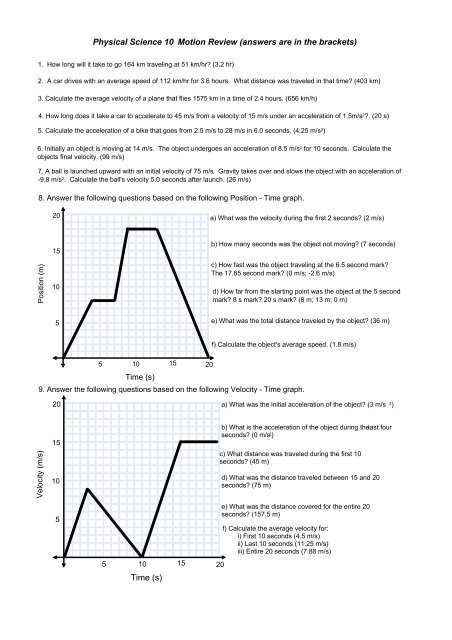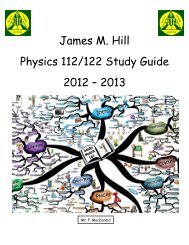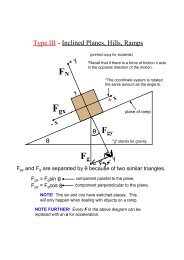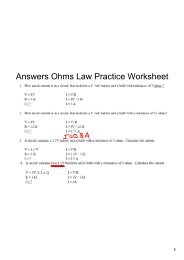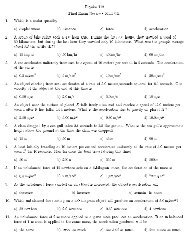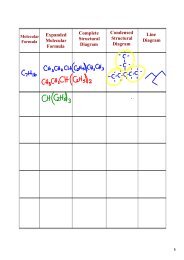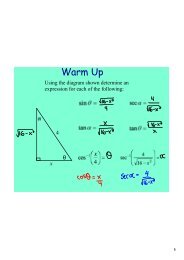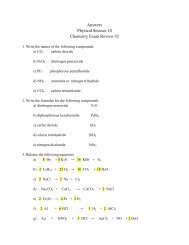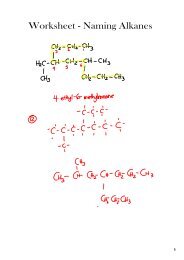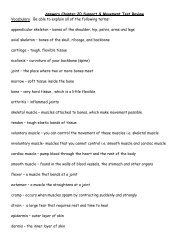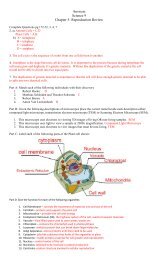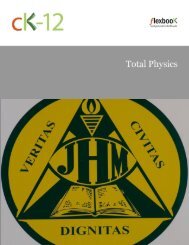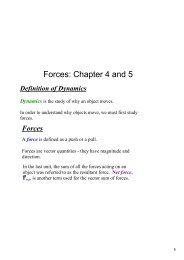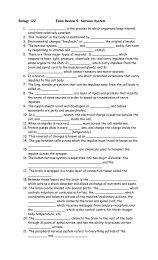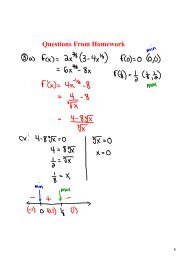Physical Science 10 Motion Review (answers are in the brackets ...
Physical Science 10 Motion Review (answers are in the brackets ...
Physical Science 10 Motion Review (answers are in the brackets ...
- No tags were found...
You also want an ePaper? Increase the reach of your titles
YUMPU automatically turns print PDFs into web optimized ePapers that Google loves.
<strong>Physical</strong> <strong>Science</strong> <strong>10</strong> <strong>Motion</strong> <strong>Review</strong> (<strong>answers</strong> <strong>are</strong> <strong>in</strong> <strong>the</strong> <strong>brackets</strong>)<br />
1. How long will it take to go 164 km travel<strong>in</strong>g at 51 km/hr (3.2 hr)<br />
2. A car drives with an average speed of 112 km/hr for 3.6 hours. What distance was traveled <strong>in</strong> that time (403 km)<br />
3. Calculate <strong>the</strong> average velocity of a plane that flies 1575 km <strong>in</strong> a time of 2.4 hours. (656 km/h)<br />
4. How long does it take a car to accelerate to 45 m/s from a velocity of 15 m/s under an acceleration of 1.5m/s 2 . (20 s)<br />
5. Calculate <strong>the</strong> acceleration of a bike that goes from 2.5 m/s to 28 m/s <strong>in</strong> 6.0 seconds. (4.25 m/s 2 )<br />
6. Initially an object is mov<strong>in</strong>g at 14 m/s. The object undergoes an acceleration of 8.5 m/s 2 for <strong>10</strong> seconds. Calculate <strong>the</strong><br />
objects f<strong>in</strong>al velocity. (99 m/s)<br />
7. A ball is launched upward with an <strong>in</strong>itial velocity of 75 m/s. Gravity takes over and slows <strong>the</strong> object with an acceleration of<br />
9.8 m/s 2 . Calculate <strong>the</strong> ball's velocity 5.0 seconds after launch. (26 m/s)<br />
8. Answer <strong>the</strong> follow<strong>in</strong>g questions based on <strong>the</strong> follow<strong>in</strong>g Position Time graph.<br />
20<br />
a) What was <strong>the</strong> velocity dur<strong>in</strong>g <strong>the</strong> first 2 seconds (2 m/s)<br />
15<br />
b) How many seconds was <strong>the</strong> object not mov<strong>in</strong>g (7 seconds)<br />
Position (m)<br />
<strong>10</strong><br />
c) How fast was <strong>the</strong> object travel<strong>in</strong>g at <strong>the</strong> 6.5 second mark<br />
The 17.85 second mark (0 m/s; 2.6 m/s)<br />
d) How far from <strong>the</strong> start<strong>in</strong>g po<strong>in</strong>t was <strong>the</strong> object at <strong>the</strong> 5 second<br />
mark 8 s mark 20 s mark (8 m; 13 m; 0 m)<br />
5<br />
e) What was <strong>the</strong> total distance traveled by <strong>the</strong> object (36 m)<br />
f) Calculate <strong>the</strong> object's average speed. (1.8 m/s)<br />
5 <strong>10</strong> 15 20<br />
Time (s)<br />
9. Answer <strong>the</strong> follow<strong>in</strong>g questions based on <strong>the</strong> follow<strong>in</strong>g Velocity Time graph.<br />
20<br />
a) What was <strong>the</strong> <strong>in</strong>itial acceleration of <strong>the</strong> object (3 m/s 2 )<br />
Velocity (m/s)<br />
15<br />
<strong>10</strong><br />
b) What is <strong>the</strong> acceleration of <strong>the</strong> object dur<strong>in</strong>g <strong>the</strong> last four<br />
seconds (0 m/s 2 )<br />
c) What distance was traveled dur<strong>in</strong>g <strong>the</strong> first <strong>10</strong><br />
seconds (45 m)<br />
d) What was <strong>the</strong> distance traveled between 15 and 20<br />
seconds (75 m)<br />
5<br />
5 <strong>10</strong> 15 20<br />
Time (s)<br />
e) What was <strong>the</strong> distance covered for <strong>the</strong> entire 20<br />
seconds (157.5 m)<br />
f) Calculate <strong>the</strong> average velocity for:<br />
i) First <strong>10</strong> seconds (4.5 m/s)<br />
ii) Last <strong>10</strong> seconds (11.25 m/s)<br />
iii) Entire 20 seconds (7.88 m/s)
<strong>10</strong>. (a) Based on <strong>the</strong> table of <strong>in</strong>formation below draw <strong>the</strong> Velocity Time graph and use it to answer <strong>the</strong><br />
questions that follow. Assume <strong>the</strong> <strong>in</strong>itial velocity is 16.0 m/s.<br />
Acceleration<br />
(m/s 2 )<br />
Time<br />
Interval (s)<br />
20<br />
4.0 0 ≤ t ≤ 4<br />
5.0 4 ≤ t ≤ 8<br />
0.0 8 ≤ t ≤ 12<br />
<strong>10</strong>.0 12 ≤ t ≤ 14<br />
1.0 14 ≤ t ≤ 20<br />
Velocity (m/s)<br />
15<br />
<strong>10</strong><br />
5<br />
5 <strong>10</strong> 15 20<br />
Time (s)<br />
b) Calculate <strong>the</strong> change <strong>in</strong> velocity, distance traveled, and average velocity dur<strong>in</strong>g each time <strong>in</strong>terval.<br />
Summarize your calculations <strong>in</strong> <strong>the</strong> table below. (note: <strong>the</strong> <strong>answers</strong> you should get <strong>are</strong> given <strong>in</strong> <strong>the</strong> table)<br />
Acceleration<br />
(m/s 2 )<br />
Time Interval<br />
(s)<br />
Δvelocity<br />
(m/s)<br />
distance<br />
(m)<br />
v avg<br />
(m/s)<br />
4.0 0 ≤ t ≤ 4<br />
16 32<br />
8.0<br />
5.0 4 ≤ t ≤ 8<br />
20 40<br />
<strong>10</strong><br />
0.0 8 ≤ t ≤ 12<br />
0.0 80<br />
20<br />
<strong>10</strong>.0 12 ≤ t ≤ 14<br />
20 20<br />
<strong>10</strong><br />
1.0 14 ≤ t ≤ 20<br />
6 18<br />
3.0<br />
c) Calculate <strong>the</strong> average velocity for <strong>the</strong> full 20 seconds. (9.5 m/s)


